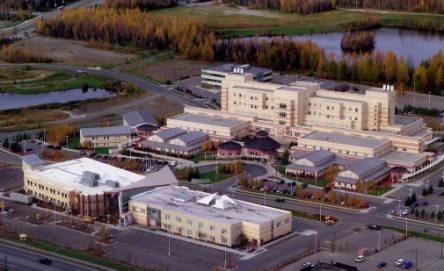|
|
|
Alaska Native Claims Settlement Act Unlike the lower 48 States where the United States established reservations for Native people, the U.S. Government took a different approach toward Alaska Natives. In 1971, the ANCSA authorized more than 200 Alaska Native villages and 13 regional corporations (see figure A-1) to take lands and become financial institutions. On the day the law was passed, all people of at least one-quarter Native blood quantum who enrolled to participate in ANCSA were issued shares of stock in Native corporations. Despite many challenges, these corporations have succeeded over the years, becoming leading business entities within Alaska.1 Figure A-1: Thirteen Alaska Native Regional Corporations. Southcentral Foundation The Cook Inlet Region, Incorporated, established a nonprofit regional health corporation, Southcentral Foundation (SCF), in 1982 to help the Native community within its geographic area to achieve physical, mental, emotional, and spiritual wellness. SCF was able to build programs specific to Alaska Native health issues, such as the Community Health Representative program, which brings care directly to the homes of Elders lacking mobility; the first fetal alcohol syndrome prevention program in the Nation; and the only minority organ and tissue program in Alaska. SCF also was able to deliver family medicine, dental care, and optometry programs directly to villages. Alaska Native Medical Center Partnering with the Alaska Native Tribal Health Consortium (which manages statewide health services) and obtaining a self-governance agreement with the Indian Health Service, SCF built the culturally sensitive Alaska Native Medical Center (ANMC), which is beautifully decorated with Alaska Native art to inspire healing. (See figure 1 in the body of this report.) The largest primary care clinic in Alaska, the Anchorage Native Primary Care Center of the ANMC, also was built by SCF. It is located across the street from the ANMC. (See figure A-2.) This care clinic features architecture inspired by Alaska’s rivers, forests, and mountains. Alaska Natives from all over the State travel to the ANMC for a spectrum of health care, including traditional healing, chiropractic care, massage therapy, and acupuncture.
Figure A-2: Air shot of Alaska
Native Medical Center (in the background) The ANMC offers patients a large health information center (see figure A-3) with 6 computers and 2 kiosks with CD-ROMs for searching health information. To the left of the health information center is the main lobby, which has an Internet café. The area to the right of the health information center houses the traditional healing program. Patients and their families relax in the lobby area, where a table is provided for people to hook up their laptops or for artisans to sell their crafts.
Figure A-3: Health Information
Center with six computers, Interviews Both 1-hour and 15-minute interviews were conducted in Alaska at the ANMC. We also visited Chickaloon Village. One-hour interviews in Alaska
Fifteen-minute interviews in Alaska A total of 21 Alaska Native patients were interviewed at the ANMC’s Primary Care Center Health Information Center. Seven were male and 14 female, representing Aleut, Athabascan, Holikachuk, Inupiat, Tanacross, and Yupik tribes. Chickaloon Village Dr. Mala arranged a visit to Chickaloon Village about one hour north of Anchorage. Interviewers were given a tour of the school (see figure A-4) and the health care clinic. The school recently won an award from Harvard University for outstanding achievement. Its seven students have access to two computers. The clinic has two computers available for public use, but they are restricted to job searches since unemployment is extremely high. All clinic staff members appear to have their own Internet access.
1McClanahan, AJ. Growing Up Native in Alaska. Anchorage: The CIRI Foundation, 2000.
|



